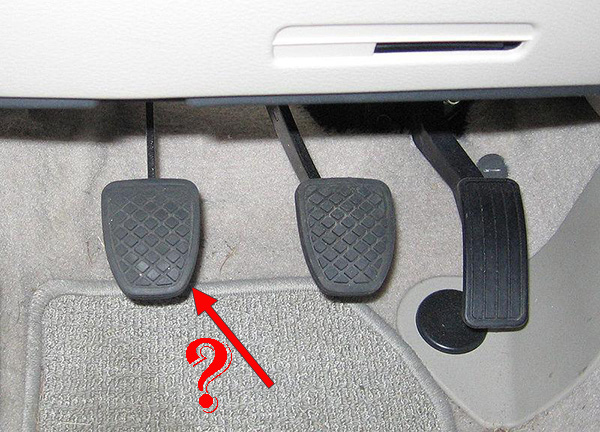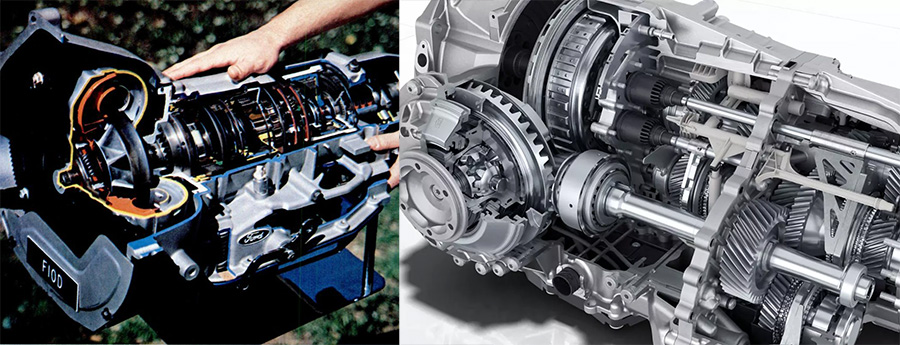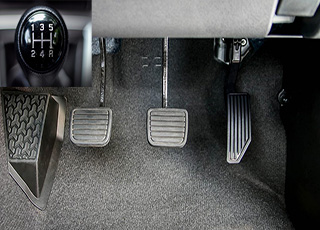While automatic transmissions are gaining popularity, the skill of driving a manual car, or “stick shift” as it’s called in the US, remains relevant. If you’re learning to drive a manual vehicle, here’s a step-by-step guide to help you understand the process.
Understanding the Basics
In manual transmission vehicles, the standard layout includes three pedals positioned from left to right: the clutch, brake, and accelerator.
Operating the brake pedal is simple: pressing it slows down the vehicle, with firmer pressure yielding quicker deceleration. Conversely, using the accelerator pedal increases engine revs, resulting in acceleration, with the degree of acceleration correlating to the pressure applied.
 The clutch pedal introduces a layer of difficulty. Essentially, it is the vital connection between the engine and the drive wheels. When depressed, the clutch disengages the engine from the wheels, allowing for gear changes without stalling the engine. This disconnection facilitates smooth gear transitions, enabling the driver to control the vehicle’s speed and power delivery effectively.
The clutch pedal introduces a layer of difficulty. Essentially, it is the vital connection between the engine and the drive wheels. When depressed, the clutch disengages the engine from the wheels, allowing for gear changes without stalling the engine. This disconnection facilitates smooth gear transitions, enabling the driver to control the vehicle’s speed and power delivery effectively.
Mastering the coordination between these three pedals is fundamental to proficiently driving a manual car. It requires a nuanced understanding of how each pedal interacts with the vehicle’s transmission system. With practice and experience, drivers develop a natural feel for operating the clutch, brake, and accelerator in harmony, ensuring smooth and efficient driving experiences.
Driving a Manual Car
● Start by fastening your seatbelt upon entering the car.
● Insert the key into the ignition and turn it to start the engine.
● Depress the clutch pedal with your left foot (the pedal on the left).
● Shift the gear stick into first gear.
● Gently press the accelerator with your right foot to increase the engine’s revs slightly.
● Slowly release the clutch pedal until you feel it vibrating slightly.
● This vibration indicates the “bite point,” where the clutch plates begin to engage.
● Release the handbrake, and the car will start moving slowly.
● Gradually increase the revs while lifting your foot off the clutch until the car moves forward solely using the accelerator pedal.
Remember, releasing the clutch too quickly or without enough revs can cause the car to stall. If this happens, apply the brakes, turn off the engine, return the gear stick to neutral, and restart the process.
Driving Uphill
When facing uphill terrain with a manual transmission vehicle, it’s advisable to downshift to a lower gear to sustain sufficient power output. This strategic gear adjustment ensures the engine can efficiently overcome the increased resistance posed by the incline. Additionally, you may find it necessary to apply slightly more pressure to the accelerator than usual to maintain a consistent speed while ascending.
However, it’s essential to exercise caution when transitioning back to level ground. As the slope diminishes, gradually reduce accelerator input and transition to a higher gear to optimise fuel efficiency and engine performance.
When initiating a hill start, deploying the handbrake can provide added stability and control. This technique allows one foot to remain dedicated to operating the clutch while the other manages the accelerator, minimising the risk of rolling backward. By implementing these hill-driving strategies, drivers can navigate challenging inclines with confidence and precision, ensuring smooth and safe travels regardless of the terrain’s elevation.
Clutch Maintenance Tips
To prolong the life of your clutch:
● Avoid using the clutch to hold the car on hills or creep forward at junctions. Instead, engage the handbrake and use the clutch only when ready to move.
● Refrain from keeping the clutch depressed while stopped, as this can accelerate wear on the clutch release bearing.
● Minimise revs to prevent unnecessary wear on the clutch plates. Gentle acceleration is key to preserving the clutch.
Manual Gearboxes: Then and Now

Modern manual cars now commonly offer at least five gears, providing drivers with more options for optimising performance and fuel efficiency. Moreover, six-speed transmissions have become increasingly prevalent in today’s vehicles, offering smoother gear shifts and enhanced driving dynamics.
When we consider high-performance cars, some models are equipped with seven-speed manual transmissions, catering to enthusiasts seeking maximum control and precision during spirited driving. These advanced gearboxes allow for seamless gear changes, enabling drivers to extract the full potential of their vehicles on both the road and the track.
Advantages of Manual Gearboxes
Affordability and Fuel Efficiency – Manual cars are often more budget-friendly to purchase and maintain compared to their automatic counterparts. Additionally, manual transmissions typically offer better fuel efficiency, helping drivers save money on fuel costs over time.
Enhanced Control – Manual gearbox enthusiasts appreciate the greater sense of control they have over their vehicles. Manual transmission allows for precise gear selection, particularly beneficial during manoeuvres like overtaking on highways or navigating winding roads.
Performance in Challenging Conditions – In adverse weather conditions such as snow or mud, manual gearboxes excel. Drivers can leverage manual gear selection to effectively manage torque delivery, providing better traction and control over the vehicle’s movements. This enhanced control contributes to improved safety and confidence while driving in challenging environments.
Advanced Techniques: Heel-and-Toe
Once comfortable with manual driving, consider mastering advanced techniques like “heel-and-toe.” This involves rev-matching while downshifting, enhancing driving precision and control. While not essential for everyday driving, mastering this skill can be rewarding, especially for track enthusiasts.
Driving a manual car may seem daunting at first, but with practice, it becomes second nature. There is a lot of joy that comes with driving a manual car but you also have the added benefits of independence. However, it might seem quite challenging and complex to learn how to drive a manual car but in reality, it is relatively simple once you begin learning and heading out on the open road.
Follow these steps and tips to master the art of manual transmission driving and enjoy a fulfilling driving experience.



